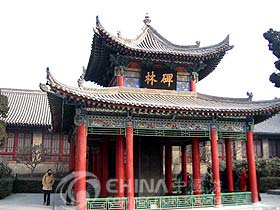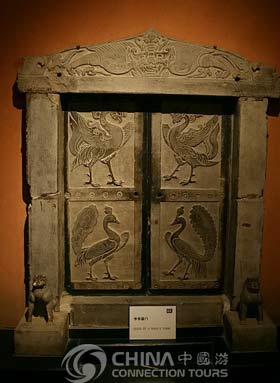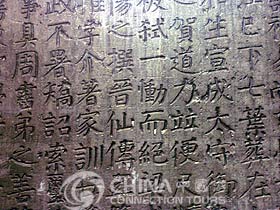
 Once the Temple of Confucius, the Xian Forest of Steles at Sanxuejie Street nearby the South Gate in Xi'an was originally built in Northern Song dynasty (1090 A.D.) when a large Confucian collection of steles cut in A.D. 837 - the oldest existing texts of the Confucian classics - was moved here for safekeeping. It gained the present name in the 18th century and boasted the largest collection of its kind in China.
Once the Temple of Confucius, the Xian Forest of Steles at Sanxuejie Street nearby the South Gate in Xi'an was originally built in Northern Song dynasty (1090 A.D.) when a large Confucian collection of steles cut in A.D. 837 - the oldest existing texts of the Confucian classics - was moved here for safekeeping. It gained the present name in the 18th century and boasted the largest collection of its kind in China.
The contents of the Forest Steles can be divided into four groups: works of literature and philosophy, historical records, calligraphy and pictorial stones.
One of the more striking exhibits is the Forest of Steles, the heaviest collection of books in the world with the earliest of these more than 2,000 large engraved stone tablets dates from the Han dynasty. Most interesting includes an enlargement to the Confucian Classics stone inscriptions in the Tang dynasty. With the successive collections of Steles in the Song, Jin, Yuan, Ming and Qing dynasties, it was gradually renovated and expanded like a forest of steles. The Popular Stele of Daiqin Nestorianism, which can be recognizable by the small cross at the tip and engraved in 781 A.D., marks the opening of a Nestorian church. The Monk Bu Kong Stele in Tang dynasty (A.D. 781) is noteworthy for its Buddhist value.
Xian Forest of Stone Steles is an art treasure-house with the oldest and richest collection of steles in China. It is not only one of the centers of ancient Chinese stone-engraving classics, but also the focus of the works of art of celebrated calligraphers of past dynasties. The numerous standing steles resemble a forest, hence the name "Forest of Steles"'. With a history of almost 900 years, it is an art gem renowned at home and abroad.
 The Forest of Steles is an enlargement to the Confucian Classics stone inscriptions in the Tang Dynasty. Shitai Xiaojing (stele engraved with the Canon of Filial Piety) and Kaicheng Shijing ( steles engraved with the Confucian Classics) of the Tang Dynasty were originally kept in the Imperial Academy in Wu Ben District of Chang'an, the capital of the Tang Dynasty ( in the vicinity of the present Wen Yi Street, southern Xi'an). Following the devastation in the late Tang Dynasty, Chang'an was rebuilt with its size reduced by the order of Han Jian, magistrate of Chang'an. In 904 AD the engraved Confucian Classics were moved inside the Wen Xuan Temple (in the vicinity of the present She Hui Street of Xi'an).Due to poor environment, in the second year of Yuan You of the Song Dynasty, (1087 AD) on the suggestion of Lu Dazhong, all the Confucian Classics and other valued Tang steles were moved to the present site of the Forest of Steles under the auspices of Li Chi. Thus the foundation of the Forest of Steles was initially laid. With the successive collections of Steles in the Song, Jin, Yuan, Ming and Qing dynasties, it was gradually renovated and expanded, making one feel among a forest of steles. But it was not until the early Qing Dynasty that the name "Forest of Steles" was finally chosen. Based on the design of Liang sicheng, China's well-known architect, the Forest of Steles was extensively renovated in 1937, and was completed in Feb. 1938, looking in the main the way it does today.
The Forest of Steles is an enlargement to the Confucian Classics stone inscriptions in the Tang Dynasty. Shitai Xiaojing (stele engraved with the Canon of Filial Piety) and Kaicheng Shijing ( steles engraved with the Confucian Classics) of the Tang Dynasty were originally kept in the Imperial Academy in Wu Ben District of Chang'an, the capital of the Tang Dynasty ( in the vicinity of the present Wen Yi Street, southern Xi'an). Following the devastation in the late Tang Dynasty, Chang'an was rebuilt with its size reduced by the order of Han Jian, magistrate of Chang'an. In 904 AD the engraved Confucian Classics were moved inside the Wen Xuan Temple (in the vicinity of the present She Hui Street of Xi'an).Due to poor environment, in the second year of Yuan You of the Song Dynasty, (1087 AD) on the suggestion of Lu Dazhong, all the Confucian Classics and other valued Tang steles were moved to the present site of the Forest of Steles under the auspices of Li Chi. Thus the foundation of the Forest of Steles was initially laid. With the successive collections of Steles in the Song, Jin, Yuan, Ming and Qing dynasties, it was gradually renovated and expanded, making one feel among a forest of steles. But it was not until the early Qing Dynasty that the name "Forest of Steles" was finally chosen. Based on the design of Liang sicheng, China's well-known architect, the Forest of Steles was extensively renovated in 1937, and was completed in Feb. 1938, looking in the main the way it does today.
What attracts people most is that the Forest of Steles has gathered the famous works of many outstanding calligraphers  handed down from ancient times. Chinese calligraphy has a long history, and in general has evolved from the complex to the simple. It has five basic script forms, namely: seal script, clerical script, regular script, running script and cursive script. Through more than 5,000 years of creative work and development these various forms have constituted the abundant treasure and unique traditions of the art of Chinese calligraphy. For example, the Cao Quan Stele, written in Han clerical script in the 2nd year of Zhongping (185 AD) in the Eastern Han Dynasty, is famous for its elegant, ingenious and clear inscription, as well as its completeness. The Tang Dynasty witnessed the prosperous period of our art of calligraphy. Ouyang Xun, Yu Shinan,Zhu Suiliang, Yan Zhenqing and Liu Gongquan developed their own distinctive styles of regular script, while Ouyang Tong, Xu Hao, Shi Weize, Huai Su, Zhang Xu and Li Yangbing were celebrated calligraphers of different script forms. The most distinguished Tang stele is "the Preface to the Holy Buddhist Scriptures" in the handwriting of Wang Xizhi, a famous Jin calligrapher. The valuable poems and works of calligraphy of such famous post-Tang calligraphers as Su Shi, Huang Tingjian, Mi Fei, Zhao Mengfu, Dong Qichang and Zhu Yongming are also collected in the Forest of Steles.
handed down from ancient times. Chinese calligraphy has a long history, and in general has evolved from the complex to the simple. It has five basic script forms, namely: seal script, clerical script, regular script, running script and cursive script. Through more than 5,000 years of creative work and development these various forms have constituted the abundant treasure and unique traditions of the art of Chinese calligraphy. For example, the Cao Quan Stele, written in Han clerical script in the 2nd year of Zhongping (185 AD) in the Eastern Han Dynasty, is famous for its elegant, ingenious and clear inscription, as well as its completeness. The Tang Dynasty witnessed the prosperous period of our art of calligraphy. Ouyang Xun, Yu Shinan,Zhu Suiliang, Yan Zhenqing and Liu Gongquan developed their own distinctive styles of regular script, while Ouyang Tong, Xu Hao, Shi Weize, Huai Su, Zhang Xu and Li Yangbing were celebrated calligraphers of different script forms. The most distinguished Tang stele is "the Preface to the Holy Buddhist Scriptures" in the handwriting of Wang Xizhi, a famous Jin calligrapher. The valuable poems and works of calligraphy of such famous post-Tang calligraphers as Su Shi, Huang Tingjian, Mi Fei, Zhao Mengfu, Dong Qichang and Zhu Yongming are also collected in the Forest of Steles.
Many inscriptions in Xian Forest of Steles are of precious historical value, such as the world-famous Nestorian Stele and Monk Bu Kong Stele. Gathered here are also some carved sketches with exquisite and splendid decorative designs, making the Forest of Steles, the art treasure-house, all the more brilliant and well-known far and near.

